ECU AUDI A3 2012 Owner´s Manual
[x] Cancel search | Manufacturer: AUDI, Model Year: 2012, Model line: A3, Model: AUDI A3 2012Pages: 280, PDF Size: 70.11 MB
Page 154 of 280
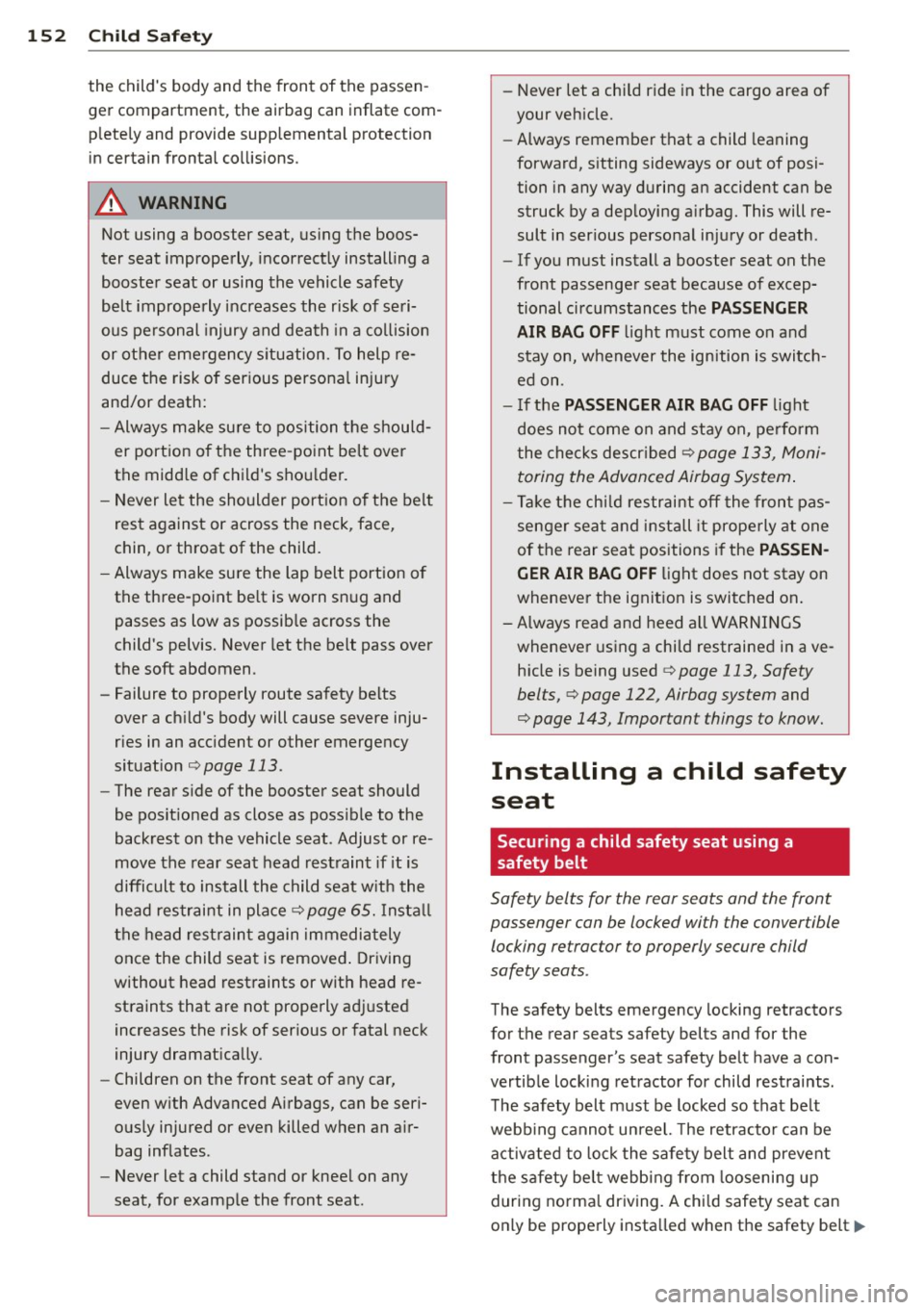
152 Child Safety
the child's body and the front of the passen
ger compartment , the airbag can inflate com
pletely and provide supplemental protection
in certain frontal collisions .
A WARNING
Not using a booster seat, using the boos
ter seat improperly, incorrectly installing a
booster seat or using the vehicle safety
belt improperly increases the risk of seri
ous personal injury and death in a collision
or other emergency situation. To help re
duce the risk of serious personal injury
and/or death:
- Always make sure to position the should
er portion of the three-point belt over
the middle of child's shoulder.
- Never let the shoulder portion of the belt
rest against or across the neck , face,
chin, or throat of the child.
- Always make sure the lap belt portion of
the three-point belt is worn snug and
passes as low as possible across the
child's pelvis. Never let the belt pass over
the soft abdomen.
- Failure to properly route safety belts
over a child's body will cause severe inju
ries in an accident or other emergency
situation
c;,page 113.
-The rear side of the booster seat should
be positioned as close as possible to the
backrest on the vehicle seat . Adjust or re
move the rear seat head restraint if it is
difficult to install the child seat with the
head restraint in place
¢page 65. Install
the head restraint again immediately
once the child seat is removed. Driving
without head restraints or with head re
straints that are not properly adjusted
increases the risk of serious or fatal neck
injury dramatically.
- Children on the front seat of any car,
even with Advanced Airbags, can be seri
ously injured or even killed when an air
bag inflates .
- Never let a child stand or kneel on any
seat, for example the front seat.
-
- Never let a child ride in the cargo area of
your vehicle.
- Always remember that a child leaning
forward, sitting sideways or out of posi
tion in any way during an accident can be
struck by a deploying airbag. This will re
sult in serious personal injury or death .
- If you must install a booster seat on the
front passenger seat because of excep
tional circumstances the
PASSENGER
AIR BAG OFF
light must come on and
stay on, whenever the ignition is switch
ed on.
- If the
PASSENGER AIR BAG OFF light
does not come on and stay on, perform
the checks described
c;, page 133, Moni
toring the Advanced Airbag System.
- Take the child restraint off the front pas
senger seat and install it properly at one
of the rear seat positions if the
PASSEN
GER AIR BAG OFF
light does not stay on
whenever the ignition is switched on.
- Always read and heed all WARNINGS
whenever using a child restrained in ave
hicle is being used
c;, page 113, Safety
belts,
c;, page 122, Airbag system and
c;, page 143, Important things to know.
Installing a child safety
seat
Securing a child safety seat using a
safety belt
Safety belts for the rear seats and the front
passenger can be locked wi th the convertible
locking retractor to properly secure child
safety seats.
The safety belts emergency locking retractors
for the rear seats safety belts and for the
front passenger's seat safety belt have a con
vertible locking retractor for child restraints.
The safety belt must be locked so that belt
webbing cannot unreel. The retractor can be
activated to lock the safety belt and prevent
the safety belt webbing from loosening up
during normal driving. A child safety seat can
only be properly installed when the safety belt
IJll-
Page 155 of 280
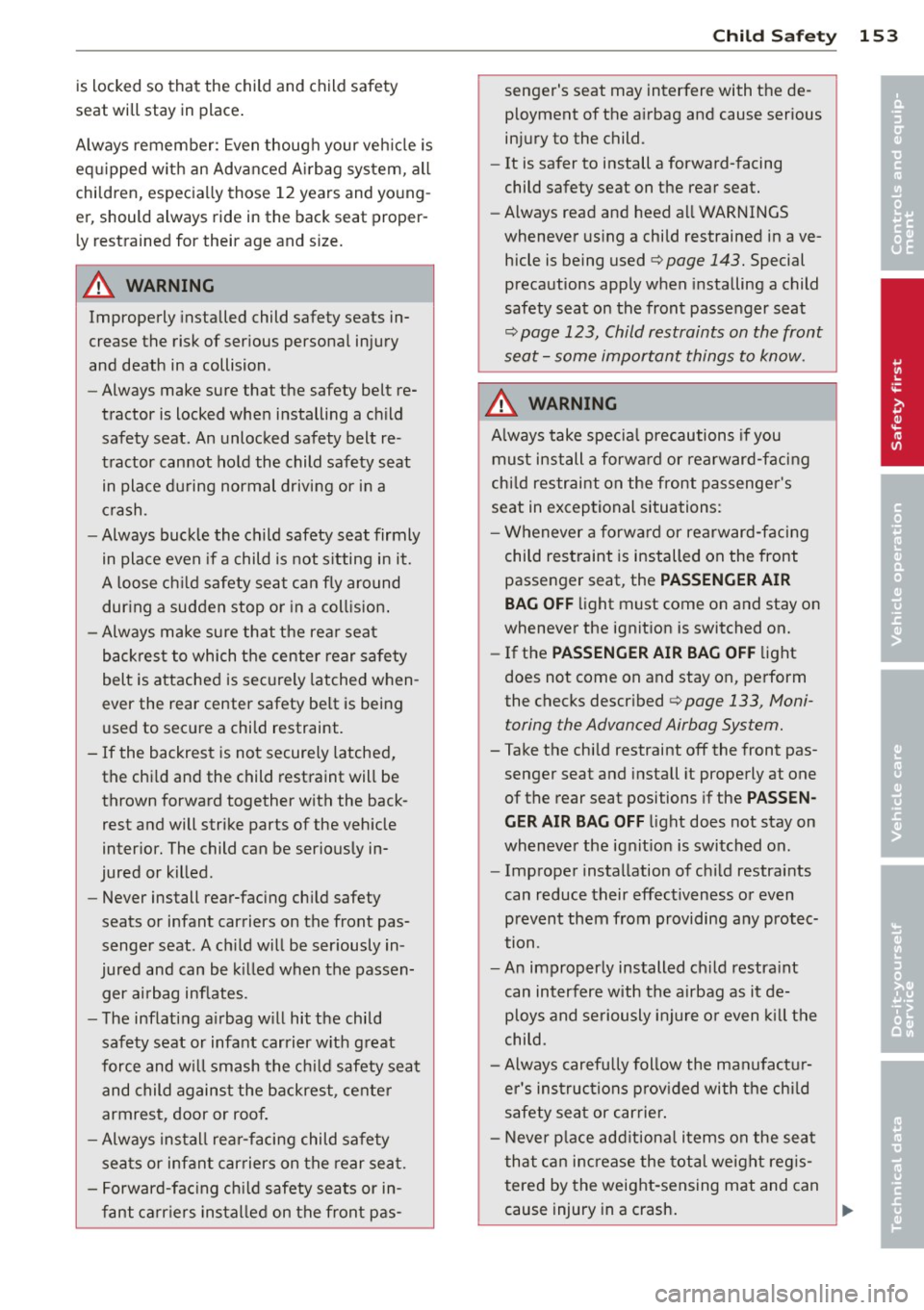
is locked so that the child and child safety
seat will stay in place.
Always remember: Even though your vehicle is
equipped with an Advanced Airbag system, all
children , especially those 12 years and young
er, should always ride in the back seat proper
ly restrained for their age and size.
A WARNING
Improperly installed child safety seats in
crease the risk of serious personal injury
and death in a collision.
- Always make sure that the safety belt re
tractor is locked when installing a child
safety seat. An unlocked safety belt re
tractor cannot hold the child safety seat
in place during normal driving or in a
crash.
- Always buckle the child safety seat firmly
in place even if a child is not sitting in it.
A loose child safety seat can fly around
during a sudden stop or in a collision.
- Always make sure that the rear seat
backrest to which the center rear safety
belt is attached is securely latched when
ever the rear center safety belt is being
used to secure a child restraint.
- If the backrest is not securely latched,
the child and the child restraint will be
thrown forward together with the back
rest and will strike parts of the vehicle
interior. The child can be seriously in
jured or killed.
- Never install rear-facing child safety
seats or infant carriers on the front pas
senger seat . A child will be seriously in
jured and can be killed when the passen
ger airbag inflates.
- The inflating airbag will hit the child
safety seat or infant carrier with great
force and will smash the child safety seat and child against the backrest, center
armrest, door or roof.
- Always install rear-facing child safety
seats or infant carriers on the rear seat.
- Forward-facing child safety seats or in
fant carriers installed on the front pas-
Child Safety 153
senger's seat may interfere with the de
ployment of the airbag and cause serious
injury to the child.
- It is safer to install a forward-facing
child safety seat on the rear seat.
- Always read and heed all WARNINGS
whenever using a child restrained in ave
hicle is being used
c=> page 143. Special
precautions apply when installing a child
safety seat on the front passenger seat
c=> page 12 3, Child restraints on the front
seat -some important things to know.
A WARNING
Always take special precautions if you
must install a forward or rearward-facing
child restraint on the front passenger's
seat in exceptional situations:
- Whenever a forward or rearward-facing
child restraint is installed on the front
passenger seat, the
PASSENGER AIR
BAG OFF
light must come on and stay on
whenever the ignition is switched on.
- If
the PASSENGER AIR BAG OFF light
does not come on and stay on, perform
the checks described
c=> page 133, Moni
toring the Advanced Airbag System.
- Take the child restraint off the front pas senger seat and install it properly at one
of the rear seat positions if the
PASSEN
GER AIR BAG OFF
light does not stay on
whenever the ignition is switched on .
- Improper installation of child restraints
can reduce their effectiveness or even
prevent them from providing any protec
tion.
-An improperly installed child restraint
can interfere with the airbag as it de ploys and seriously injure or even kill the
child.
-Always carefully follow the manufactur
er's instructions provided with the child
safety seat or carrier.
- Never place additional items on the seat
that can increase the total weight regis
tered by the weight-sensing mat and can
cause injury in a crash.
~
•
•
Page 157 of 280

A WARNING
Using the wrong child restraint or an im
properly installed child restraint can cause
ser ious personal injury or death in a crash .
- Always make sure that the safety belt re-
tractor is locked when installing a child
safety seat. An unlocked safety belt re
tractor cannot hold the child safety seat
in place during normal driving or in a
crash .
- Always buck le the child safety seat firmly
in place even if a child is not s itting in it .
A loose ch ild safety seat can fly around
dur ing a sudden stop or in a crash.
- Always make sure the seat backrest to
wh ich the child restra int is installed is in
an upr ight position and secu rely latched
in to place and cannot fold forwa rd. Oth
erwise, the seatback w ith the ch ild s afety
seat attached to it could fly forward in
the event of an accident or other emer
gency situation.
- Always read and heed all WARN INGS
whenever using a child rest rained in ave
hicle is being used
,::!) page 143. Special
precautions apply when installing a ch ild
safety seat on the front passenger seat
¢ page 123, Child restraints on the front
seat -some important things to know.
Deactivating the convertible locking
retractor
The convertible locking retractor for child re
straints will be deactivated automatically when the belt is wound all the way ba ck into
the retractor.
~ Press the red button on the safety be lt
buc kle. The belt tongue will pop out of the
bu ck le.
~ G ui de the safety belt all the way back in to
it s stowed posit ion .
A lways le t the safety belt retract comp lete ly
in to its stowed posit ion. The sa fety belt can
now be used as an o rdinary sa fety belt with
out the convert ib le lock ing ret ractor for chi ld
restra ints.
-
Child Sa fet y 155
If the convertib le locking retractor should be
activated inadvertently, the safety be lt must
be unfastened and guided comp lete ly back in
to its stowed posit ion to deactivate this fea
ture. If the convert ible locking retractor is not
deact ivated, the safety belt w ill grad ua lly be
come tig hte r and uncomfortable to wear.
A WARNING
Im prop erly installed chi ld safety seats in
crease the r isk of serio us pe rsonal injury
a nd death in a c ollision.
- Never unfasten the safety belt to deacti
vate the conver tible locking retrac to r for
child res traints while the vehicle is mov
ing . You would not be restrained and
could be seriously injured in an accide nt.
- Always read and heed al l WAR NIN GS
wheneve r using a child restraine d in ave
hicle is being used
r::!) page 143 . Special
preca utions apply when insta lling a child
safety seat on the front passe nger seat
¢ page 123, Child restraints on the front
seat -some important things to know .
LATCH Lower
anchorages and tethers
for children
Child Restraint System anchors and how
are they related to child safety
T o p rov ide a simple r and more prac ticable way
to attach the c hild restraint on the vehi cle
seat, Federal regulat ions req uire spec ia l lower
anchorages in vehicles and devices on new
c hi ld restra ints to attach to the veh icle ancho
rages.
The combination of the tether anchorages and
the lower anchorages is now genera lly ca lled
the
LATCH system for " Lower Anchorages and
T ethers for Chil dren."
Fo rward-faci ng chi ld restraints manufactured
after September 1, 1999, are requ ired by U.S.
federa l regu lations to comply with new child
head movement performance requirements. .,.. •
•
Page 158 of 280
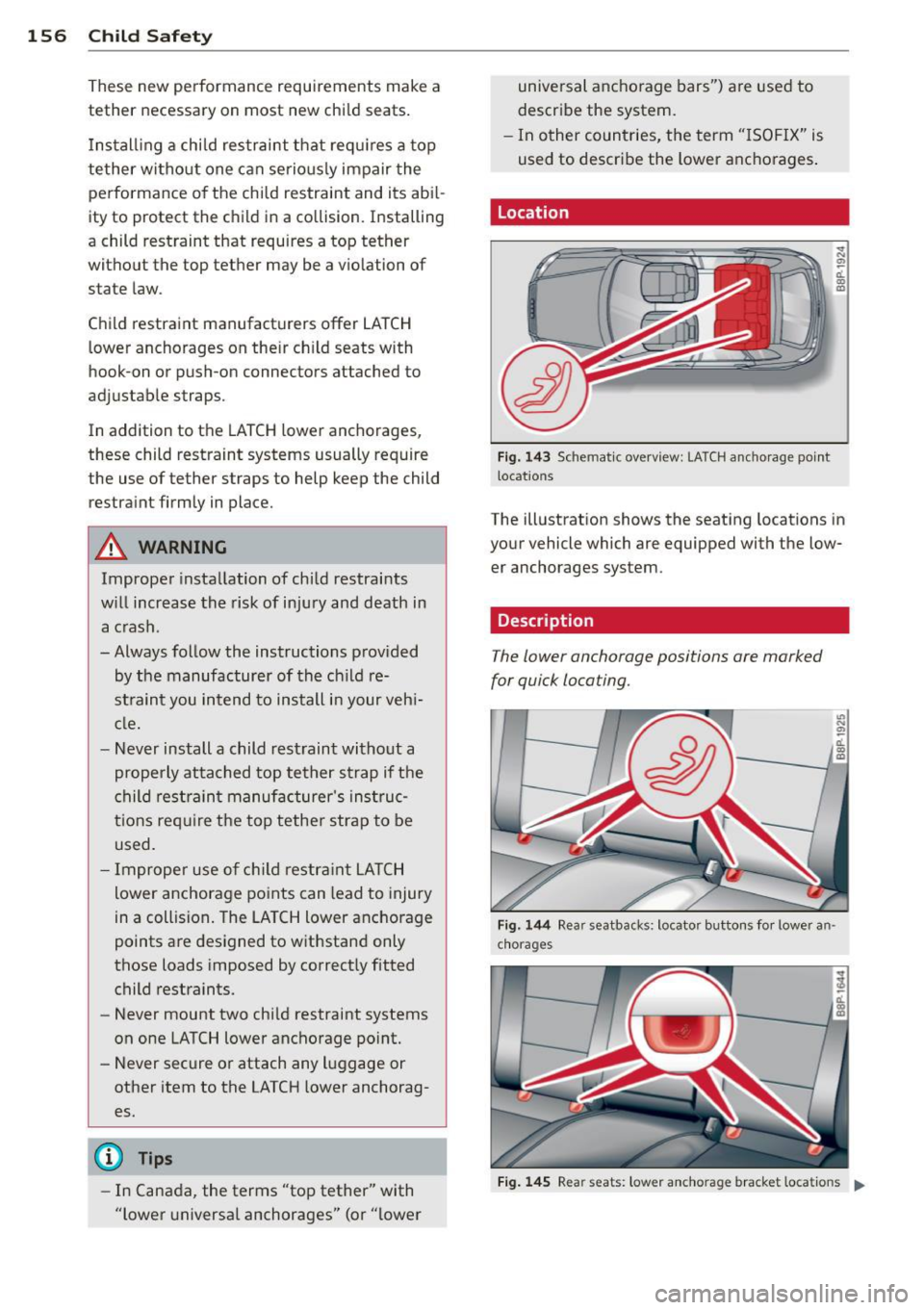
156 Child Safet y
These new performance requirements make a
tether necessary on most new child seats.
Ins tal ling a chi ld restraint that requ ires a top
tether without one can serious ly impair the
performance of the child restraint and its abi l
ity to protect the chi ld in a co llis ion. Installing
a child restraint that requires a top tether
witho ut the top tether may be a v io lation of
state law .
Child restraint manufacturers offer LATCH l ower anchorages on the ir ch ild seats with
hook-on or push -on connectors attached to
adjustable straps.
In addit ion to the LATCH lower anchorages ,
these child restraint systems usually require
the use of tether straps to help keep the child restraint firmly in place.
A WARNING
Improper insta llation of chi ld restraints
w ill increase the risk of injury and death in
a c rash .
- Always follow the instructions p rov ided
by the manufacturer of the ch ild re
st raint you intend to install in your veh i
cle.
- Never install a child restraint without a
properly atta ched top tether strap if the
child rest rain t manufacturer's instruc
tions req uire the top tethe r strap to be
used.
- Improper use of c hild restra int LA TCH
lower anchorage points can lead to injury
in a collis ion . The LATCH lower anchorage
points are designed to w ithstand only
those loads imposed by correct ly fitted
child restraints.
- Never mount two chi ld restraint systems
on one LATCH Lower anchorage point.
- Never secure or attach any L uggage or
other item to the LATCH lower anchorag
es.
@ Tips
- In Canada, the terms "top tether" with
"lower universa l anchorages" (or " lower
-
unive rsal ancho rage bars") a re used to
describe the system.
- In o ther coun tries, the term " ISOFI X" is
used to describe the Lower anc ho rages .
Location
Fig. 143 Sch emat ic overview: LATCH anc horage po int
l ocat io ns
a, ~ ti. m a,
The illustration shows the seating locations in
your vehicle which are equipped with the low er anchorages system.
Description
The lower anchorage positions are marked
for quick locating.
F ig. 1 44 Rear seatbacks: locato r buttons fo r lowe r an
c h ora g es
Fi g. 14 5 Rear seats: low er an cho rage bracket loca tions .,.
Page 159 of 280
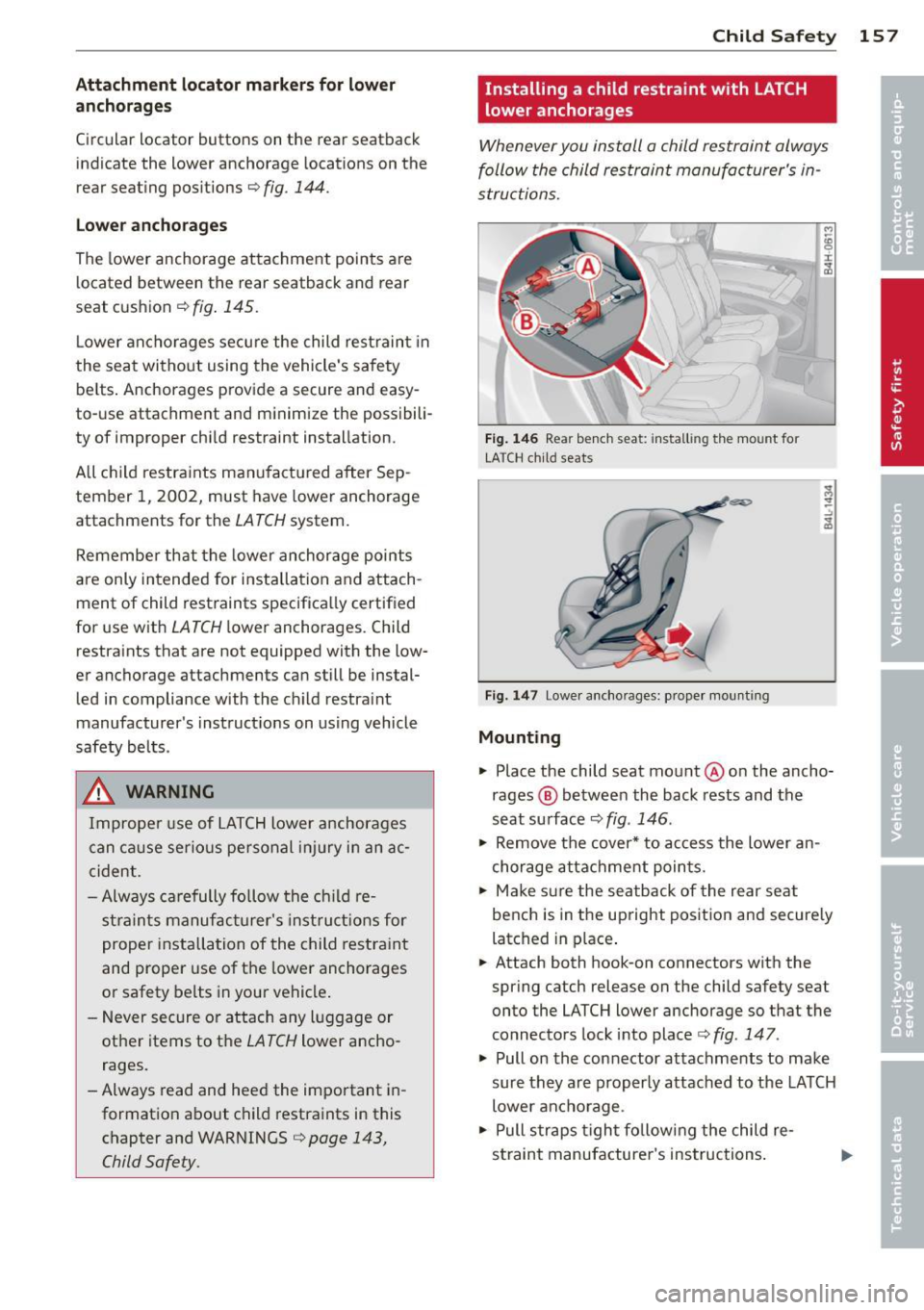
Attachment locator markers for lower
anchorages
Circular locator buttons on the rear seatback indicate the lower anchorage locations on the
rear seating positions ¢
fig. 144.
Lower anchorages
The lower anchorage attachment points are
l ocated between the rear seatback and rear
seat cushion ¢
fig. 145.
Lower anchorages secure the child restraint in
the seat witho ut using the vehicle 's safety
be lts . Anchorages provide a secure and easy
to-use attachment and minimize the possibili
ty of improper child restraint installation.
A ll child restraints manufactured after Sep
tember 1, 2002, must have lower anchorage
attachments for the
LATCH system.
Remember that the lower anchorage points
are only intended for installation and attach
ment of child restraints specifically certif ied
for use with
LATCH l ower anchorages . Child
restraints that are not equipped with the low
er anchorage attachments can still be instal led in compliance with the ch ild restra int
manufacturer's instruct ions on using vehicle
safety belts .
.&, WARNING
Improper use of LATCH lower anchorages
can cause serious persona l injury in an ac
cident .
- Always carefully fo llow the child re
straints manufacturer's instructions for
proper installation of the child restraint
and proper use of the lower anchorages
or safety belts in your vehicle.
- Never secure or attach any l uggage or
other items to the
LATCH lower ancho
rages.
-Always read and heed the important in
formation about child restraints in this
chapter and WARNINGS ¢
page 143,
Child Safety .
Child Safety 15 7
Installing a child restra int with LATCH
lower anchorages
Whenever you install a child restraint always
follow the child restraint manufacturer's in
structions.
Fig. 146 Rear bench seat: insta llin g the mount fo r
LATCH child seats
Fig. 147 Lower anchorages: proper mount ing
Mounting
.,. Place the child seat mount@on the ancho
rages @ between the back rests and the
seat surface ¢
fig. 146 .
.,. Remove the cover* to access the lower an
chorage attachment points.
.,. Make sure the seatback of the rear seat
bench is in the upright position and secure ly
latched in place.
.,. Attach both hook-on connectors with the
spring catch release on the child safety seat
onto the LATCH lower anchorage so that the
connectors lock into place ¢
fig. 147.
.,. Pull on the connector attachments to make
sure they are properly attached to the LATCH
lower anchorage .
.,. Pull straps tight fo llowing the child re-
straint manufacturer's instructions . .,..
Page 160 of 280
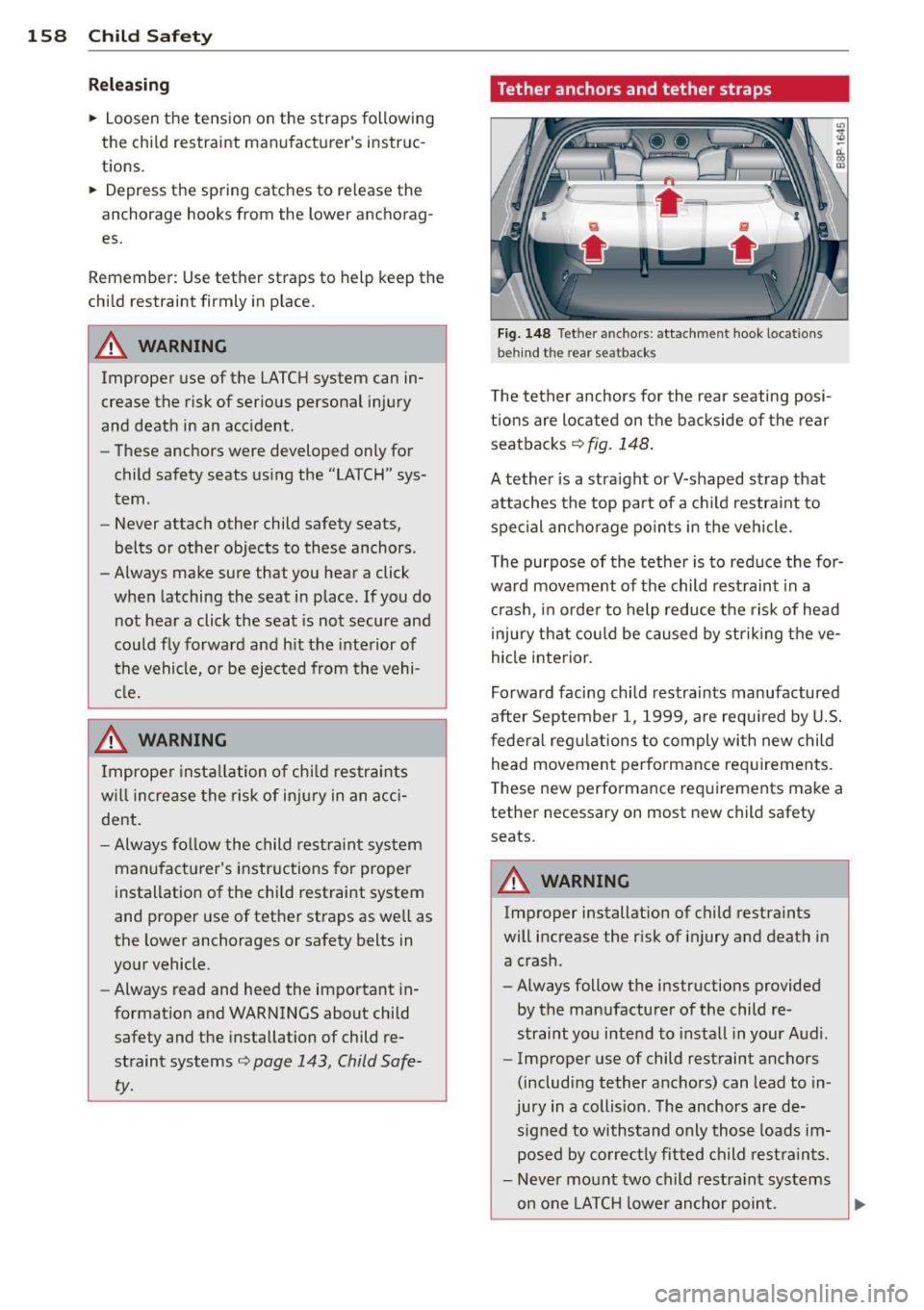
158 Child S afet y
Relea sin g
.,. Loosen the tension on the straps following
the chi ld restraint manufacturer 's instruc
tions .
.,. Depr ess th e spr ing catch es to re lease the
a nchorage hooks from the lowe r anchorag
es.
Rem emb er: Use tether straps to help keep the
child restraint fi rmly in p lace.
A WARNING
Improper use of the LATCH system can in
crease the risk of serious personal injury
and death in an acc ident.
- These anchors were developed only for
child safety seats us ing the "LATCH" sys
tem .
- Never attach other child safety seats,
belts or other objects to these anchors .
- Always make sure that you hear a click
when latching the seat in place . If you do
not hear a click the seat is not secure and
could fly forward and h it the interior of
the vehicle, or be ejected from the vehi
cl e.
&_ WARNING
Imprope r insta llation of chi ld restrai nts
w ill increase the risk of inju ry in an acc i
dent.
- Always fo llow the child restraint system
man ufa cturer's instr uctions for proper
installation of the child restraint system
and proper use of tether straps as we ll as
the lower anchorages or sa fety belts in
your vehicle .
- Always read and heed the important in
format ion and WARNINGS about child
safety and the installation of child re
straint systems
c:> page 143, Child Safe
ty.
Tether anchors and tether straps
F ig. 148 Tet her an ch ors : attachment hook loca tions
b ehi nd the rea r se atba cks
T he tether anchors for the rear seating posi
tions are located on the backside of the rear
seatbacks
c:> fig. 148.
A tether is a stra ight or V-shaped st rap that
attaches the top par t of a ch ild restra int to
spe cial ancho rage po in ts in the vehicle.
The purpose of the tether is to reduce the for
ward movement of the child rest raint in a
cr ash , in orde r to help reduce the risk of head
injury that cou ld be caused by str ik ing the ve
hicle interior.
Forward facing child restraints manufactured
after September 1, 1999, are requ ired by U.S.
federa l reg ulations to comply wi th new child
head movemen t perfo rmance req uirements.
T hese new performa nce req uirements make a
tether necessary on most new child safety seats .
&_ WARNING
-Improper installat ion of child restra ints
will increase the risk of injury and death in
a crash .
- Always follow the instructions provided
by the manufacturer of the child re
straint you intend to install in your Audi .
- Improper use of child restraint anchors
(including tether anchors) can lead to in
jury in a collis ion. The anchors are de
s igned to withstand only thos e loads im
posed by co rrec tly fitted child rest rain ts.
- Never mo unt two child restra int sys tems
-
on one LATC H lower anchor point. .,_
Page 161 of 280
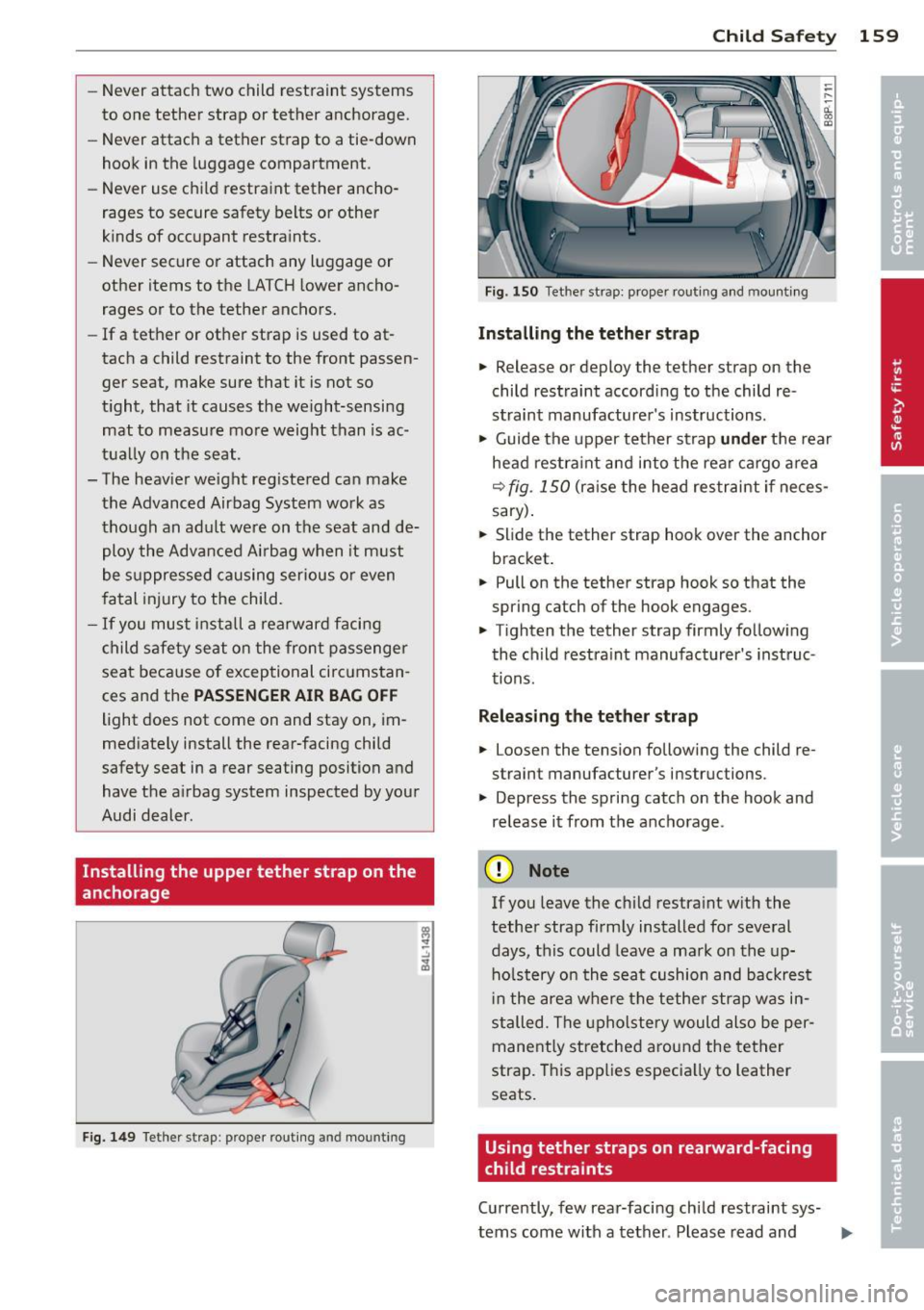
-Never attach two child restraint systems
to one tether strap or tether anchorage.
- Never attach a tether strap to a tie-down
hook in the luggage compartment.
- Never use child restraint tether ancho
rages to secure safety belts or other
kinds of occupant restraints.
- Never secure or attach any luggage or
other items to the LATCH lower ancho
rages or to the tether anchors.
-If a tether or other strap is used to at
tach a child restraint to the front passen ger seat, make sure that it is not so
t ight , that it causes the weight-sensi ng
mat to measure more weight than is ac
tually on the seat .
- The heav ier weight reg istered can make
the Advanced Airbag System work as
though an adult were on the seat and de
ploy the Advanced Ai rbag when it must
be s uppressed causing serious o r even
f atal injury to the child.
- If you mus t install a rearward facing
child safe ty seat o n the fron t passenger
seat beca use of exceptional circ ums tan
ces and the
PASSENGER AIR BAG OFF
light does not come on and stay on , im
med iately install the rear -facing child
safety seat in a rear seating position and
have the a irbag system inspected by you r
Audi dealer.
Installing the upper tether strap on the
anchorage
F ig. 1 49 Tether strap : prope r ro utin g and mountin g
Child S afety 159
Fig. 1 50 Tet her st rap: prope r routing an d mounti ng
Installing the tether str ap
.. Release or deploy the te ther s trap on the
child restraint according to the child re
straint manufacture r's instructions .
.. Guide the upper tether st rap
und er the rear
head restra int and into the rea r cargo a rea
r=;, fig . 150 (ra ise the head restraint if neces
sary) .
.. Slide the tether strap hook over the anchor
bracket.
.. Pull on the tether st rap hook so th at the
spring cat ch of the hook engages .
.. Tighten the tether strap firmly follow ing
the child restra int manufacturer's inst ruc
tions.
Relea sing the tether strap
.. Loosen the tension following the ch ild re
strain t manufac turer 's ins truc tions .
.. Depress the spring catch on the hook and
release it from the anchorage .
(D Note
If you leave the child restraint w ith the
tether strap firm ly installed for several
days, this could leave a ma rk on the up
ho lstery on the seat cushion and backrest
i n the area where the tether strap was in
stalled. The upholstery would also be per
mane ntly stretched a round the tether
strap. T his app lies especia lly to leather
seats.
Using tether straps on rearward-facing
child restraints
Cu rrently, few rear-facing child restraint sys-
tems come with a tether . Please read and ...,
Page 176 of 280
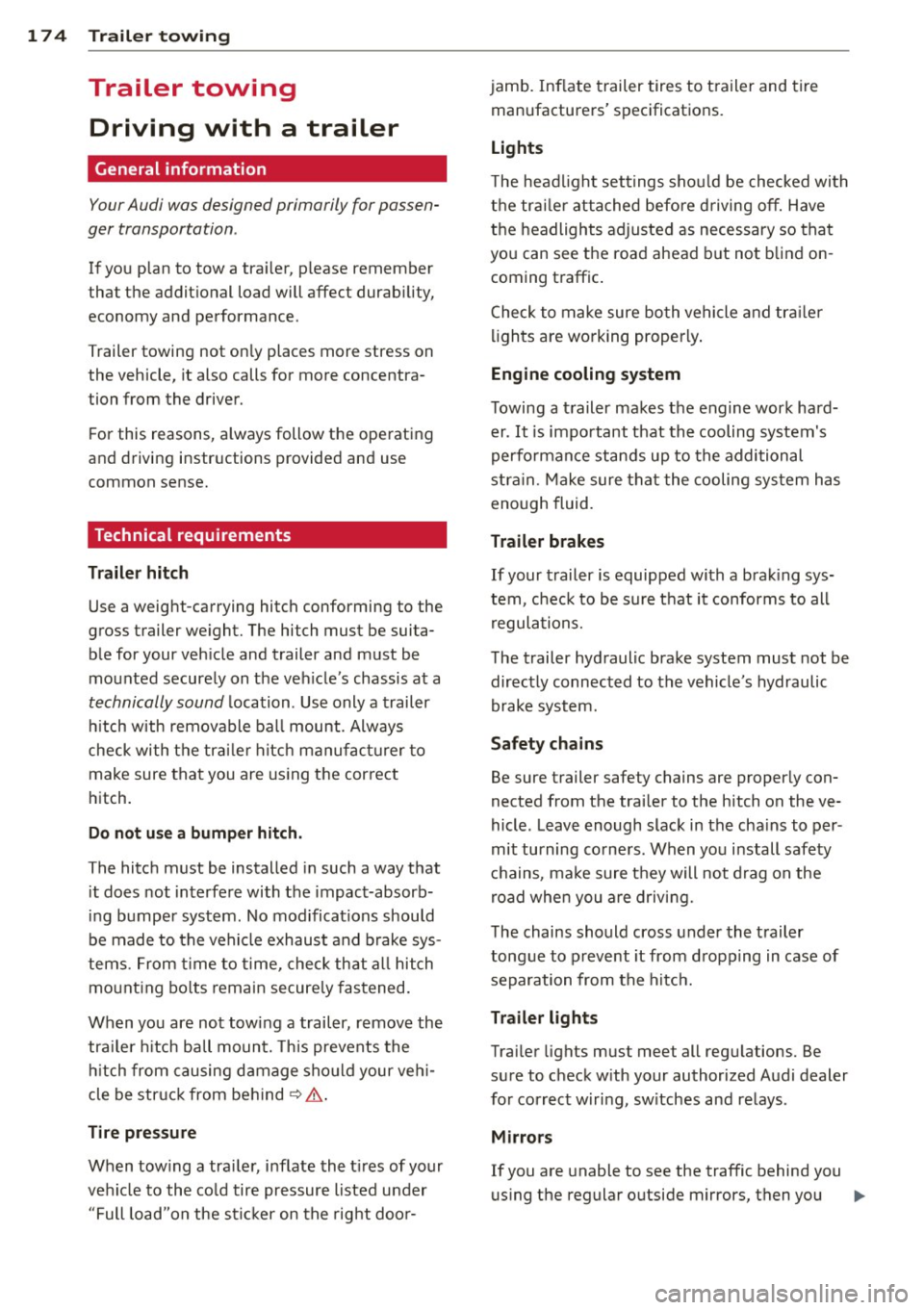
174 Trailer towing
Trailer towing Driving with a trailer
General information
Your Audi was designed primarily for passen
ger transportation .
If you plan to tow a tra iler, p lease remember
that the addit ional load will affect durability,
economy and performance.
T railer towing not on ly places more stress on
the vehicle, it also calls for more concentra
tion from the driver.
F or this reasons, always follow the operating
and drivi ng in str uctions provided and use
common sense.
Technical requirements
Traile r hitch
Use a weight-carrying hitch conforming to the
gross trailer weight. The hitch must be suita
b le for your veh icle and trailer and must be
mounted securely on the ve hicle's chassis at a
technically sound location. Use only a trailer
h itch with removable ba ll mount. Always
check with the tr ailer hitch manufac turer to
make sure tha t you are using t he cor rect
hitch.
Do not us e a bumper hitch .
The hitch must be installed in such a way that
it does not interfere with the impact-absorb
ing bumper syst em. No modifications should
be made to the vehi cle exhaust and brake sys
tems. From time to time, check th at a ll hitch
mo unt ing bo lts remain securely fastened.
When you are not towing a trailer, remove the
tra iler hitch ball mount. This prevents the
h itch from causing damage sho uld your ve hi
cle be str uck from behind
¢ A .
Tire pressure
When tow ing a traile r, inflate the t ires of your
ve hicle to the co ld tire pressure listed under
"Full load"on the stick er on the rig ht doo r- jamb. Inflate trailer tires to trailer and tire
manufacturers' specifications.
Lights
T he headlight set tings sho uld be checked with
t h e trai le r attached before d riving o ff. Have
the headlights adjusted as necessary so tha t
yo u can see t he road ahead b ut not blind on
coming traffic.
Check to make sure bo th ve hicle and tr ailer
lights are wo rk ing properly .
Engine cooling system
T owing a t railer makes the engine work hard
er.
It i s impo rtant that the cooling system's
performance stands up to the additional
stra in. Make sure tha t the cooling sys tem has
enough fluid.
Trailer brakes
If your trailer is equipped with a brak ing sys
tem, c heck to be sure t hat it conforms to all
regula tions.
The trailer hyd raulic brake system must not be
directly connected to the vehicle's hydraulic
brake system.
Safety ch ains
Be sure trailer safety chains are properly con
nected from the trailer to the hitch on the ve
hicle. Leave enough slack in the cha ins to per
mit turning co rne rs. When yo u in stall safety
c h ains, ma ke sure they will not drag on the
r oad when you a re driving.
The chains should cross under the t railer
tong ue to prevent it from dropping in case of
separation from the h itch.
Trailer lights
Trai ler lights must meet all regulations. Be
sure to check w ith your authorized Audi dealer
for correct w ir in g, sw itches and re lays .
Mir rors
If you are unable to see the traffic behind you
us ing the regular outside mirrors, then you
Page 196 of 280

194 Checking and filling
Checking and filling
Engine hood
Releasing the engine hood
The engine hood is released from inside the
vehicle .
Fig. 155 Driver' s side footwe ll: e ngin e hood release
lever
.. Open the driver's door.
.. Pull the release lever on the left under the
instrument panel
c> fig . 155 in direction of
the a rrow .
The hood pops up slight ly under spring pres
sure.
Opening the engine hood
Fig . 156 Engine hood releas e le ve r
Before opening the eng ine hood, make sure
that the windshie ld wipers are folded flat
against the windshield . Otherwise, they could
damage the paint on the hood.
.. Pull the release lever
r=;,fig . 156 in the direc
tion indicated by the arrow . This release the
hook under the hood .
.. Open the hood all the way.
A WARNING
-Hot engine coolant can burn you!
- To reduce the risk of being burned, never
open the hood if you see or hear steam
or coo lant escaping from the eng ine
compartment . Wait unt il no steam or
coolant can be seen or heard before care
fu lly opening the hood.
Closing the engine hood
.. Pull the hood down until the pressure from
the strut is reduced .
.. Let the hood
drop down and latch in p lace.
Do not try to push it shut; it may fail to en
gage
c> .&, .
A WARNING
--
A hood that is not completely latched
could fly up and b lock your view while dr iv
i ng.
- When you close the engine hood, check it
to make sure the safety catch has properly engaged . The hood shou ld be flush
with the surrounding vehicle body parts.
- If you notice while dr iv ing that the hood
is not secured properly, stop at once and
close it .
Working in the engine compartment
Be especially careful whenever you work in
the engine compartment!
Whene ve r you must pe rform any wo rk in the
eng ine compartment, for e xample chec king
and filling differ ent fluid s, the re i s a risk of
injury , burns and accident s. T o pr event p er
s onal injury alwa ys observe the foll owing
WARNING S. Th e engin e c ompartm ent of an y
v e hicl e is a hazardou s area!
r=;, .&.
A WARNING
To help avoid injury, before yo u check any
thing under the hood:
- Turn off the engine .
- Remove the ignition key.
Page 204 of 280
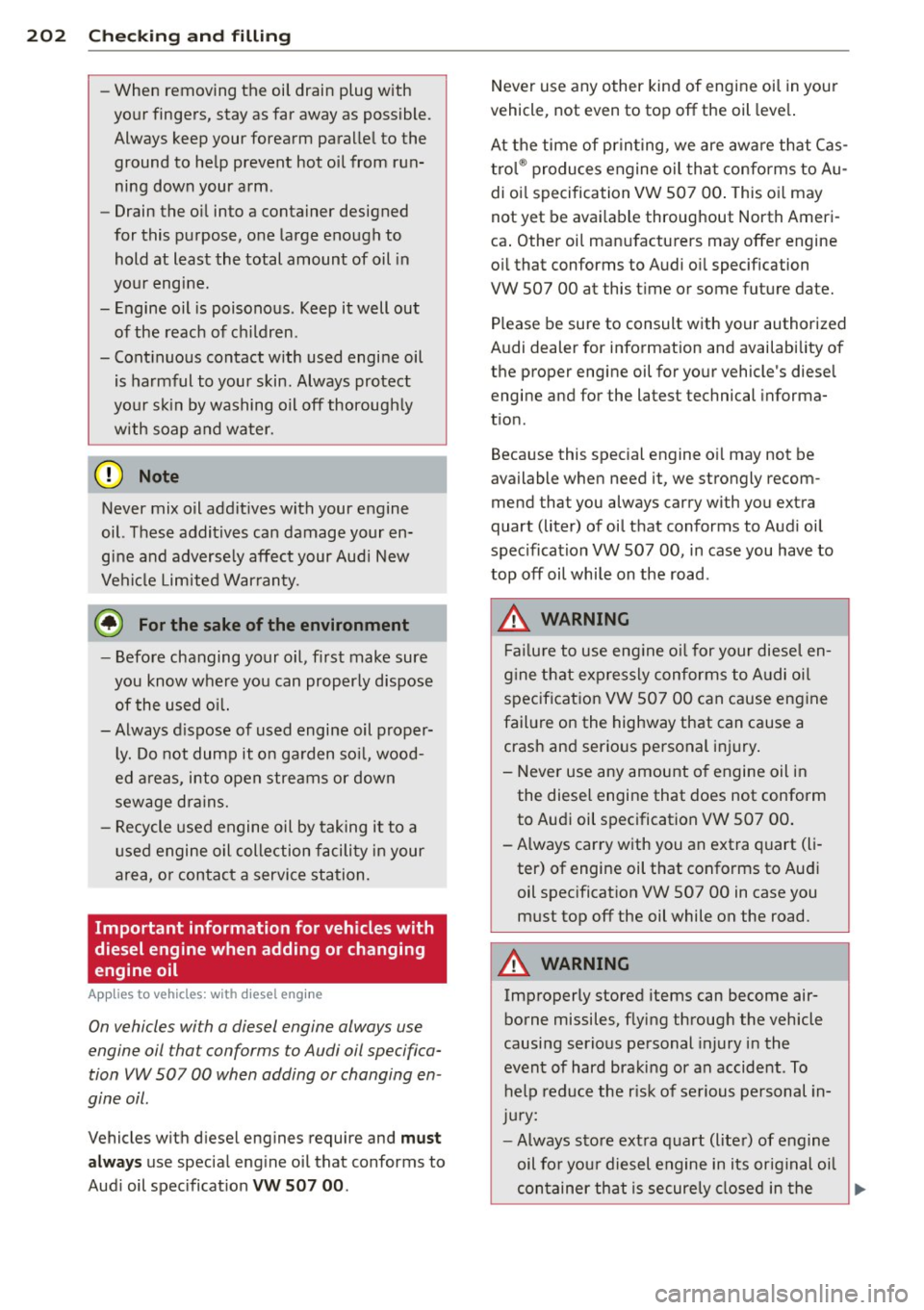
202 Checking and filling
-When removing the oil drain plug with
your fingers, stay as far away as possible.
Always keep your forearm parallel to the
ground to help prevent hot oil from run
ning down your arm.
- Drain the oil into a container designed
for this purpose, one large enough to
hold at least the total amount of oil in
your engine.
- Engine oil is poisonous. Keep it well out
of the reach of children .
- Continuous contact with used engine oil
is harmful to your skin. Always protect
your skin by washing oil off thoroughly
with soap and water.
(D Note
Never mix oil additives with your engine
oil. These additives can damage your en
gine and adversely affect your Audi New
Vehicle Limited Warranty.
@) For the sake of the environment
- Before changing your oil, first make sure
you know where you can properly dispose
of the used oil.
-Always dispose of used engine oil proper
ly. Do not dump it on garden soil, wood
ed areas, into open streams or down
sewage drains.
- Recycle used engine oil by taking it to a
used engine oil collection facility in your
area, or contact a service station.
Important information for vehicles with
diesel engine when adding or changing
engine oil
App lies to vehicles: with diesel engine
On vehicles with a diesel engine always use
engine oil that conforms to Audi oil specifica
tion VW
507 00 when adding or changing en
gine oil.
Vehicles with diesel engines require and
must
always
use special engine oil that conforms to
Audi oil specification
VW 507 00 .
Never use any other kind of engine oil in your
vehicle, not even to top off the oil level.
At the time of printing, we are aware that Cas
trol ® produces engine oil that conforms to Au
di oil specification VW 507 00. This oil may
not yet be available throughout North Ameri
ca. Other oil manufacturers may offer engine
oil that conforms to Audi oil specification
VW 507 00 at this time or some future date.
Please be sure to consult with your authorized
Audi dealer for information and availability of
the proper engine oil for your vehicle's diesel
engine and for the latest technical informa
tion .
Because this special engine oil may not be
available when need it, we strongly recom
mend that you always carry with you extra
quart (liter) of oil that conforms to Audi oil
specification VW 507 00, in case you have to
top off oil while on the road .
.&, WARNING
Failure to use engine oil for your diesel en
gine that expressly conforms to Audi oil
specification VW 507 00 can cause engine
failure on the highway that can cause a crash and serious personal injury.
- Never use any amount of engine oil in
the diesel engine that does not conform
to Audi oil specification VW 507 00.
- Always carry with you an extra quart (li ter) of engine oil that conforms to Audi
oil specification VW 507 00 in case you must top off the oil while on the road.
.&, WARNING
Improperly stored items can become airborne missiles, flying through the vehicle
causing serious personal injury in the
event of hard braking or an accident . To
help reduce the risk of serious personal in
Jury:
-Always store extra quart (liter) of engine
oil for your diesel engine in its original oil
container that is securely closed in the
~